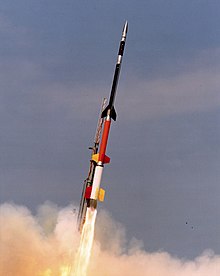Sounding rocket

A sounding rocket (also sounding rocket or height rocket called) is an unmanned missile , with the aid of physical measurements in the atmosphere to be performed. These are mostly meteorological measurements, such as those of air pressure, temperature or wind speed in the atmosphere, but also measurements of other kinds, such as the investigation of the electrical properties of the ionosphere . In addition, astronomical observations or material science investigations are carried out with the help of sounding rockets.
properties
A sounding rocket is usually a ballistic missile that consists of a propelling solid rocket and a payload container attached . Preparations for the start are much easier than z. B. in space travel. Measuring instruments for scientific research are carried as a payload at altitudes between 45 km and over 1,200 km. Depending on the objective, the following instruments can be used:
- Cameras for earth observation or for sky observation
- Temperature sensors
- Pressure sensors
- Spectrometers of all kinds (including mass spectrometers and gas chromatographs )
- Tracking transmitter (can be identical to the transmitters used for telemetry)
- Radio receiver - for measuring the ionosphere
- Instruments for weightlessness experiments
In many cases, the measuring instruments fall back to earth on parachutes after they have been deployed at height , to be recovered there and their measurements evaluated, on the other hand the measurement data can also be transmitted by radio.
In principle, guided or unguided liquid, hybrid or solid rockets can be used as rockets. For cost reasons, unguided solid rockets are mostly used today as sounding rockets - provided the experiment does not require any special orientation. Guided solid rockets are only used for experiments that require an exact trajectory. Liquid and hybrid missiles are occasionally used for heavier payloads.
Sounding rockets are often launched from mobile launchers in order to be able to expand their operational radius significantly.
Special experiments
To measure wind speeds, either the position of a measuring capsule, which returns to earth on a parachute and which can also have other measuring devices (e.g. to determine the temperature), is determined, or metal-coated plastic strips are thrown off, the trajectory of which can be tracked with a radar device. It is also possible to create artificial clouds, for example from titanium dioxide . In order to measure the magnetic field of the earth, canisters with alkali or alkaline earth metals are carried, which are made to explode at the apex of the orbit. These easily ionizable elements are ionized by solar radiation, and the charged ions are distributed depending on the field lines.
Examples of sounding rockets
- Argo E-5
- Asp
- Astrobee
- Black Brant
- Cajun
- Deacon
- Journeyman
- Lockheed X-17
- Loki
- M-100
- meteor
- MMR06
- Nike Apache
- Nike Cajun
- Nike Tomahawk
- Orion
- Sidewinder arcas
- Skylark
- T-7
- terrier
- Tianying
- Zenith
See also
literature
- NASA Sounding Rockets User Handbook , July 2005
- Günter Seibert: The History of Sounding Rockets and Their Contribution to European Space Research , published by ESA, November 2006
Web links
- ESA: Sounding rockets (English)
- NASA Sounding Rocket Program - Science and User's Website (English)